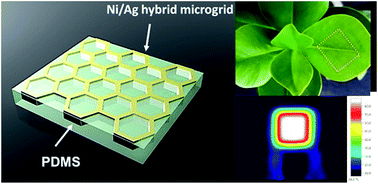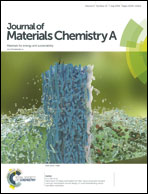High-performance electrothermal and anticorrosive transparent heating stickers†
Abstract
In this study, the fabrication of a high-performance electrothermal and anticorrosive transparent heating sticker employing a novel Ni/Ag hybrid microgrid electrode is reported. The proposed sticker not only exhibits an excellent optoelectronic performance (a sheet resistance of 4.3 Ω sq−1 at a transmittance of 96%) but also has a uniform heat distribution over its entire area owing to the electrical uniformity of the honeycomb-structured microgrid electrode. The transparent heating sticker reveals outstanding thermal and chemical stability with no electrode damage even in harsh environments such as high temperatures (300 °C) and atmospheres containing sulfur in excess, due to the anti-corrosion properties of nickel (Ni). The transparent heating sticker also exhibits a high saturation temperature of over 100 °C even at a low operating voltage (5 V) because highly thermally/electrically conductive silver (Ag) is employed as a base electrode material underneath Ni. Furthermore, a successful defogging test is demonstrated with an automobile side-view mirror using the transparent heating sticker, confirming its practical applicability. Accordingly, the proposed transparent heating sticker presents a unique opportunity for developing transparent heaters with superior chemical stability and a high electrothermal performance.



 Please wait while we load your content...
Please wait while we load your content...